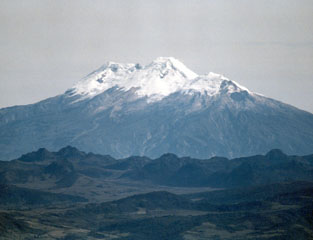Report on Nevado del Huila (Colombia) — 18 April-24 April 2007
Smithsonian Institution / US Geological Survey
Weekly Volcanic Activity Report, 18 April-24 April 2007
Managing Editor: Sally Sennert.
Please cite this report as:
Global Volcanism Program, 2007. Report on Nevado del Huila (Colombia) (Sennert, S, ed.). Weekly Volcanic Activity Report, 18 April-24 April 2007. Smithsonian Institution and US Geological Survey.
Nevado del Huila
Colombia
2.93°N, 76.03°W; summit elev. 5364 m
All times are local (unless otherwise noted)
Based on satellite imagery, the Washington VAAC reported that an ash eruption from Nevado del Huila on 18 April produced a plume that drifted SW and dissipated. On 22 April, INGEOMINAS reported that during aerial observations, fumarolic activity was observed from a fissure first noted on 19 February. The fissure was approximately 2.3 km long and 0.2 km wide. A resultant plume rose to an altitude of 10.4 km (34,100 ft) a.s.l. Another fissure, extending about 2 km from the SW to the NE sector of Pico Central, also produced fumarolic emissions. Mudflows in the Páez and Símbola rivers originating on Pico Central primarily swept through the Oso ravine on the E flank and Bellavista ravine on the W flank.
According to news articles, the eruption during 17-18 April caused damage to houses and destroyed 19 bridges along the Páez and Símbola rivers. Several kilometers of a highway, used to transport goods and medicines to the population, were also destroyed. INGEOMINAS noted that there were no reported deaths or injuries as a result of the eruption.
Geological Summary. Nevado del Huila, the highest peak in the Colombian Andes, is an elongated N-S-trending volcanic chain mantled by a glacier icecap. The andesitic-dacitic volcano was constructed within a 10-km-wide caldera. Volcanism at Nevado del Huila has produced six volcanic cones whose ages in general migrated from south to north. The high point of the complex is Pico Central. Two glacier-free lava domes lie at the southern end of the volcanic complex. The first historical activity was an explosive eruption in the mid-16th century. Long-term, persistent steam columns had risen from Pico Central prior to the next eruption in 2007, when explosive activity was accompanied by damaging mudflows.
Sources: Servicio Geológico Colombiano (SGC), Washington Volcanic Ash Advisory Center (VAAC), Associated Press, Associated Press

